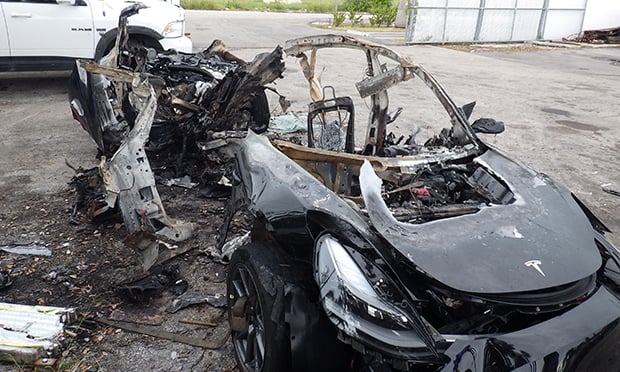 Barrett Riley had been driving at 116 mph on a curve with a posted speed limit of 25 mph on May 8, 2018. He lost control of his vehicle, a 2014 Model S, which collided with a concrete wall and burst into flames. A second passenger also died but a third passenger survived the fiery crash. (Photo: Tesla Model 3 crash, Miami-Dade County, Florida. Credit: National Transportation Safety Board)
Barrett Riley had been driving at 116 mph on a curve with a posted speed limit of 25 mph on May 8, 2018. He lost control of his vehicle, a 2014 Model S, which collided with a concrete wall and burst into flames. A second passenger also died but a third passenger survived the fiery crash. (Photo: Tesla Model 3 crash, Miami-Dade County, Florida. Credit: National Transportation Safety Board)
In the U.S. District Court for the Southern District of Florida, a jury has found Tesla 1% negligent in the death of an 18-year-old man whose Model S sedan slammed into a concrete wall after the car's speed limiter had been deactivated. The teenager and his father were found to be 99% at fault. The case is Riley v. Tesla, Inc., No. 20-CV-60517-VALLE, 2022 U.S. Dist. LEXIS 115266 (S.D. Fla. June 29, 2022).
Recommended For You
Want to continue reading?
Become a Free PropertyCasualty360 Digital Reader
Your access to unlimited PropertyCasualty360 content isn’t changing.
Once you are an ALM digital member, you’ll receive:
- Breaking insurance news and analysis, on-site and via our newsletters and custom alerts
- Weekly Insurance Speak podcast featuring exclusive interviews with industry leaders
- Educational webcasts, white papers, and ebooks from industry thought leaders
- Critical converage of the employee benefits and financial advisory markets on our other ALM sites, BenefitsPRO and ThinkAdvisor
Already have an account? Sign In Now
© Touchpoint Markets, All Rights Reserved. Request academic re-use from www.copyright.com. All other uses, submit a request to [email protected]. For more inforrmation visit Asset & Logo Licensing.







